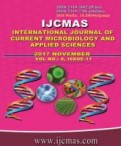


 National Academy of Agricultural Sciences (NAAS)
National Academy of Agricultural Sciences (NAAS)

|
PRINT ISSN : 2319-7692
Online ISSN : 2319-7706 Issues : 12 per year Publisher : Excellent Publishers Email : editorijcmas@gmail.com / submit@ijcmas.com Editor-in-chief: Dr.M.Prakash Index Copernicus ICV 2018: 95.39 NAAS RATING 2020: 5.38 |
The present research was based on study of follicular dynamics in cyclic (n=6) and non-cyclic (n=6) Murrah buffaloes by using 2D trans-rectal ultrasonography from day 1 to 21 of study period. During each examination, number of small (<4mm), medium (4-8mm) and large follicles (>8mm) were assessed along with diameter of medium and large follicles. Moreover, diameter of corpus luteum was also studied daily in cyclic animals. The number of small follicles was significantly (P<0.05) higher on 6th day (2.75±0.25) of cycle as compared to number of small follicles on days 4, 9, 14, 16 and 18-21 of study in cyclic animals. The number of small follicles in non-cyclic buffaloes did not differ significantly (P<0.05) on day 3 (2.00±0.00), 10 (2.00±0.00) and 20 (2.00±0.58) of observations but these were significantly higher than other days of study. Significantly higher number of medium size follicles was recorded on 6th day (4.50±1.50) as compared to day 18 and 20 of study in cyclic animals. But there was no variation in non-cyclic animals throughout the study. The number of large follicles on day 3 (1.80±0.20) versus days 15, 16 and 18-20 of study varies significantly (P<0.05) while on other days there was non-significant variation. The number of large follicles in cyclic animals varied non-significantly throughout the study. The diameter of medium sized follicles in cyclic animals on day 5 (6.77±0.42) was significantly higher than other days of cycle except days 19 and 20 of the cycle. However, the diameter of medium follicles on 1st day (7.18±.45mm) of the study was significantly higher than follicles of days 7, 11-13, 17-19 and 21 of study in non-cyclic animals. The diameter of largest follicles recorded between 11.45±2.35mm and 14.12±1.40mm in cyclic and non-cyclic animals, respectively. The large size follicle diameter on 21st day of study was significantly (P<0.05) higher than the diameter of 6th day while on other days there was non-significant variation in non-cyclic animals. In cyclic buffaloes, CL appeared on 5th day of cycle and attained maximum size on 14th day (16.43±.40mm) and then declined. From the present study, it was concluded that the selected non-cyclic animals were not in true anestrus condition as there was follicles development on ovaries that reaches to preovulatory size but not ovulated that may be due to irregular gonadotrophin synthesis or hormonal imbalance and managemental errors.
 |
 |
 |
 |
 |